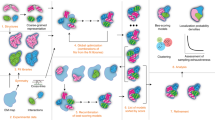Abstract
We concur with Janssen et al.1 that the structure of C3b that we reported (Protein Data Bank entry 2HR0)2 differs from the other two (2ICF (ref. 3) and 2I07 (ref. 4) in the conformation of the CUB and TED domains. The deviation of 2HR0 from 2I07 is probably relevant physiologically, considering that CUB eventually unfolds.
This is a preview of subscription content, access via your institution
Access options
Subscribe to this journal
Receive 51 print issues and online access
$199.00 per year
only $3.90 per issue
Buy this article
- Purchase on Springer Link
- Instant access to full article PDF
Prices may be subject to local taxes which are calculated during checkout

Similar content being viewed by others
References
Janssen, B. J., Read, R. J., Brünger, A. T. & Gros, P. Crystallographic evidence for deviating C3b structure. Nature 448, doi: 10.1038/nature06102 (2007).
Ajees, A. A. et al. The structure of complement C3b provides insights into complement activation and regulation. Nature 444, 221–225 (2006).
Wiesmann, C. et al. Structure of C3b in complex with CRIg gives insights into regulation of complement activation. Nature 444, 217–220 (2006).
Janssen, B. J., Christodoulidou, A., McCarthy, A., Lambris, J. D. & Gros, P. Structure of C3b reveals conformational changes that underlie complement activity. Nature 444, 213–216 (2006).
Nishida, N., Walz, T. & Springer, T. A. Structural transitions of complement component C3 and its activation products. Proc. Natl Acad. Sci. USA 103, 19737–19742 (2006).
Hammel, M. et al. A structural basis for complement inhibition by Staphylococcus aureus. Nature Immunol. 8, 430–437 (2007).
Trame, C. B. & McKay, D. B. Structure of Haemophilus influenzae HslU protein in crystals with one-dimensional disorder twinning. Acta Crystallogr. D Biol. Crystallogr. 57, 1079–1090 (2001).
McCoy, A. J., Grosse-Kunstleve, R. W., Storoni, L. C. & Read, R. J. Likelihood-enhanced fast translation functions. Acta Crystallogr. D Biol. Crystallogr. 61, 458–464 (2005).
Liszewski, M. K., Farries, T. C., Lublin, D. M., Rooney, I. A. & Atkinson, J. P. Control of the complement system. Adv. Immunol. 61, 201–283 (1996).
Pangburn, M. K. in The Complement System (eds Rother, K. & Till, G. O.) 93–117 (Springer, New York, 1998).
Chang, G., Spencer, R. H., Lee, A. T., Barclay, M. T. & Rees, D. C. Structure of the MscL homolog from Mycobacterium tuberculosis: a gated mechanosensitive ion channel. Science 282, 2220–2226 (1998).
Esnouf, R. M. et al. Continuous and discontinuous changes in the unit cell of HIV-1 reverse transcriptase crystals on dehydration. Acta Crystallogr. D Biol. Crystallogr. 54, 938–953 (1998).
Glykos, N. M. & Kokkinidis, M. On the distribution of the bulk-solvent correction parameters. Acta Crystallogr. D Biol. Crystallogr. 56, 1070–1072 (2000).
Author information
Authors and Affiliations
Corresponding author
Rights and permissions
About this article
Cite this article
Ajees, A., Gunasekaran, K., Narayana, S. et al. Crystallographic evidence for deviating C3b structure (Reply). Nature 448, E2–E3 (2007). https://doi.org/10.1038/nature06103
Published:
Issue Date:
DOI: https://doi.org/10.1038/nature06103
This article is cited by
-
Acute phase proteins are major clients for the chaperone action of α2-macroglobulin in human plasma
Cell Stress and Chaperones (2013)
Comments
By submitting a comment you agree to abide by our Terms and Community Guidelines. If you find something abusive or that does not comply with our terms or guidelines please flag it as inappropriate.



